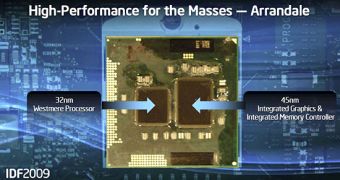For a good while now, reports of Intel's next-generation desktop and mobile processors have been made available on the Internet, in various forms, including rumors or leaked info. It now appears that we have some more or less official details, coming directly from the chip maker's IDF 2009 (Intel Developer Forum) event. The details are about the company's upcoming 32nm-based Clarkdale and Arrandale, two new processors that will be designed for the desktop and mobile segment.
The gang over at Hot Hardware was lucky enough to score some face-to-face meetings with some of Intel's representatives and engineers at this year's edition of IDF, in San Francisco, California. Among some of the details and products that they were able to lay their eyes upon, the fellows were keen on providing us with their findings on Intel's upcoming Clarkdale and Arrandale CPUs. These are two of the chip maker's upcoming mainstream desktop and mobile processor offerings and are based on the familiar Nehalem microarchitecture, featuring the company's new 32nm, 2nd generation Hi-K process.
Besides the aforementioned Nehalem microarchitecture, the new chips will also boast Intel's Turbo Boost and HyperThreading technologies, but with the added on-processor graphics core and hardware acceleration for AES (Advanced Encryption Standard).
As you might have read in previous articles, the new processors will boast up to 4MB of Intel Smart Cache, combined with an integrated memory controller (IMC), which will feature support for two channels of DDR3 memory with speeds of up to 1333MHz. With discrete graphics on, the PCI Express lanes can be configured in either 1x16 or 2x8 setups. While the processor core will be manufactured on the 32nm process technology, the integrated graphics will be based on the derivate from Intel's current graphics products and will do with a 45nm manufacturing process. According to Intel, the new graphics solution should deliver 50%+ higher performance, compared to the current X4500HD.
One of the more interesting things about the new processors is that they will enable a new computing experience that will be more energy efficient. This is an ideal feature for low-end and mainstream computer systems.

 14 DAY TRIAL //
14 DAY TRIAL //